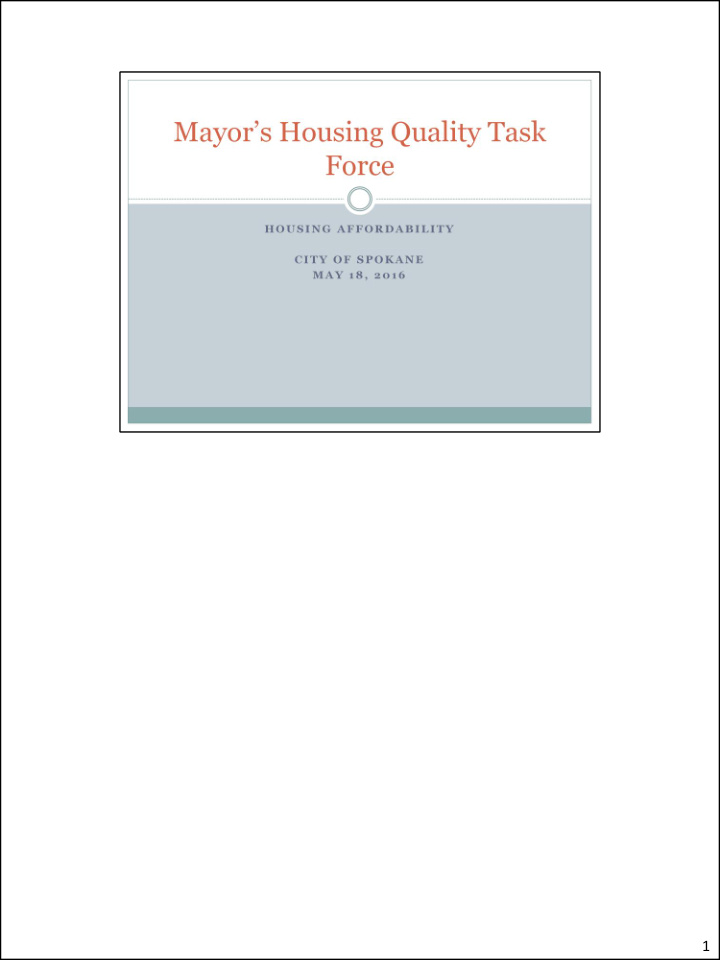



1
Understanding the dynamics of Spokane’s population, economy, housing characteristics and trends are fundamental to understanding the larger housing picture and for developing strategies to target and address the city’s affordable housing needs. Population growth – The county grew at a rate of 1.5% (6,600 people/yr) from 2004 to 2009 Spokane Country growth slowed between 2009-2012 growing at a rate of only .5% (2,500 people/yr). In 2015 the county growth rate was .79%: The City of Spokane grew at about half the county rate during the same period (.38%). growth has been fostered by local growth in education and health services Jobs & Income - While Spokane is the major urban center for Eastern Washington and North Idaho and serves as a regional center of services for surrounding rural populations; however, the area was impacted by sharp job losses from 2009-2011 (losses at a rate of 2.3% per year or 5,025). Even though non-farm payrolls rebounded by 2012 Spokane’s median income is significantly lower than national, state and county levels and more individuals live in poverty in Spokane than that reported for these other geographies (below poverty level US 15.8%, WA State 14.1%, Spokane County 17.1%, 2
Spokane City 21.2%) (2013 American Community Survey, 1yr estimate DP03). Spokane County offers only 7,000 more jobs than it did in 1999 (Spokane-Kootenai Real Estate Research Report, 2014). Home Ownership – Home ownership rates in Spokane are much lower than the nation. Single family rentals represent 38% of the total rental units in the Spokane housing market area. While at the national, state and county levels rental tenancy doesn’t exceed 38% (HUD, 2013). The City of Spokane’s current housing tenancy is nearly a 60/40 split between owner/renter occupied households. Housing Quality – Based on the American Community Survey (ACS), while nearly 60% of the City of Spokane’s housing stock was built over forty years ago, only 40% of the nation’s housing stock, 33 % of Washington’s stock and 42% of Spokane County’s structures are of that age (2013 American Community Survey, 1-year estimates). Maintenance Requirements • New construction (a home built within the last 5 to 10 years) will need very little maintenance • Homes between 10 and 20 years old will need slightly more. • At 20 years old homes generally need significant maintenance. • At 50 years or older the average home is very likely in need of major rehabilitation or replacement of major systems and building components from bathrooms and kitchens to heating, electrical systems and roofs The magnitude of housing rehabilitation need in the U.S. is staggering. In 2003, at the time of general economic prosperity and growth, it was estimated that $1.3 trillion in housing rehabilitation was needed nationwide. Further, about four-tenths, or $569 billion, of that figure is unaffordable without some measure of subsidy or other means of support (HUD 2006). Home value and rehabilitation challenges – Lower home prices and the disproportionate number of low-income residents in some neighborhoods may indicate weak market conditions Many high poverty areas include a majority share of homes built prior to 1970 and have high rental tenancy rates (tract 35 26, 20, 25, 145, 36). Neighborhoods are considered high-poverty areas when 20% or more of their population has incomes below the federal poverty line. Distressed neighborhoods are those where more than 40% of residents fall below the poverty line. 2
Housing affordability varies from household to household and many ways to measure affordability are available. A few common methods include: The Income to Debt Ratio This method gauges affordability of housing by simply calculating the maximum that a person should spend on housing. The safest way to live in the city is to avoid spending more than 28 percent of the gross income that one earns on costs that pertain to housing and no more than 36 percent on all expenses and debts. (note: a lender at the meeting identified a higher threshold for the purpose of lending activities 30% for housing and 40-45% for all other debt) Example Income to Debt Ratio threshold (values based on the 28%/36% recommendation above). • Spokane, WA has a median income of about $58,988 for people who own homes. Based on that number, a person should spend a maximum of $1,376 on expenses related to housing. • Renters have a slightly different median income, which is $25,675. Based on this average, renters should spend no more than $599 on all of their rental costs if they want to maintain a non-impoverished standard of living. Residual Income Approach 3
A standard that is become more popular is the residual income approach - With this measure, you subtract the location-based costs a household pays from their total income, and compare what’s left over – the “residual” – to what they need to spend on other necessities like food, clothes, and telecommunications. For the sake of simplicity and our discussion purposes when we speak about housing affordability we will use the HUD’s 30% standard. 3
Reference: Census publication “Who can afford to live in a home” www.census.gov/housing/census/publications/who-can-afford.pdf 4
Resource: 2015 Washington State Commerce Housing Needs Assessment www.commerce.wa.gov/Documents/Wa%20Housing%20Needs%20Assessment.pdf 5
Resources: HUD’s HOME program Annual rent data – www.hudexchange.info/manage-a-program/home-rent-limits/ Annual income data - www.hudexchange.info/manage-a-program/home-income- limits/ ALICE report - www.unitedwayalice.org/reports.php 6
Source: American Community Survey 5-year Estimates 2010-2014 7
Map created by City of Spokane GIS. Resource: Census American Community Survey household incomes and Spokane County Auditor housing conditions 8
Source: UnitedWayALICE.org/PNW 9
Source: American Community Survey 5-year Estimates, 2010-2014 10
Recommend
More recommend